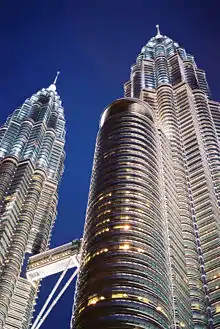Hazama Ando
Hazama Ando Corporation (安藤ハザマ株式会社, Andō Hazama Kabushiki-gaisha), is one of the 10 biggest construction companies in Japan. It was launched in 2013 by the merger of the Hazama Corporation and Ando Corporation.[3] It has overseas offices in Asia, especially in the South Asian countries like Nepal, as well as in the United States, Mexico, Central and South America.
 | |
Native name | 安藤ハザマ株式会社 |
|---|---|
| Type | Public (K.K) |
| TYO: 1719 | |
| Industry | Construction |
| Predecessor | Hazama Corporation Ando Corporation |
| Founded | (April 1, 2013) (through merger) |
| Headquarters | Akasaka, Minato-ku, Tokyo 107-8658, Japan |
Key people | Toshio Ono (Chairman of the Board of Directors) Toshiaki Nomura (President) |
| Services |
|
| Revenue | |
Number of employees | 3,850 (consolidated, as of April 1, 2017) |
| Subsidiaries | Hazama Ando Kogyo Hazama Ando (Thailand) Aoyama Kiko Hazama Ando Singapore Hazama Ando Malaysia |
| Website | Official website |
| Footnotes / references [1][2] | |
History
The predecessors of the current company, Hazama and Ando, were established in 1889 and 1873 respectively. The two companies originally formed a capital and business tie-up in 2003, and were collaborating over order receipts and materials procurement before the merger.[3]
Selected Projects
- Tokyo's Ginza Subway Line (1933)
- Kanmon Bridge (1971)
- Monseñor Óscar Arnulfo Romero International Airport - San Salvador (1980)
- One Raffles Place - Singapore (1986)[4]
- Autopolis - Hita, Japan (1989)[5]
- Kansai International Airport (1989)[6]
- Tokyo Big Sight (1995)
- New Choluteca Bridge - Choluteca, Honduras (1998)
- Kelana Jaya Line underground section (Masjid Jamek-Ampang Park), 1998[7]
- Petronas Twin Towers (Tower 1) - Kuala Lumpur (1998)[8]

The Petronas Twin Towers. One of the towers was built by Hazama.
- Chubu Centrair International Airport (airport island reclamation) (2003)
- Hải Vân Tunnel (2005)[9]
- Subic–Clark–Tarlac Expressway - Manila (2008)[10]
- Algeria East–West Highway (eastern section) (2011)[11]
See also
References
- "Corporate Profile". Hazama Ando Corporation. Retrieved April 10, 2015.
- "Company Profile". Nikkei Asian Review. Nikkei Inc. Retrieved September 1, 2017.
- "Contractors Hazama, Ando announce 2013 merger". Japan Times. May 25, 2012. Retrieved April 10, 2015.
- Binder, Georges (2006). 101 of the World's Tallest Buildings. Images Publishing. p. 107. ISBN 978-1-86470-173-9.
- Mende, Kaoru; Lighting Planners Associates Inc. (2000). Designing With Light and Shadow. Images Publishing. p. 177. ISBN 978-1-86470-041-1.
- Bachman, Leonard R. (January 27, 2004). Integrated Buildings: The Systems Basis of Architecture. John Wiley & Sons. p. 232. ISBN 978-0-471-46774-8.
- "Light Railway Transit (LRT) of Kuala Lumpur, Tunnel Work". Retrieved 19 December 2018.
- Binder, Georges (2006). 101 of the World's Tallest Buildings. Images Publishing. p. 31. ISBN 978-1-86470-173-9.
- "Hai Van Tunnel Construction Project". Japan International Cooperation Agency. August 21, 2017. Retrieved September 10, 2017.
- Hermoso, Tito F. (September 5, 2017). "SCTEx: Built against all odds". AutoIndustriya.com. Archived from the original on September 13, 2017. Retrieved September 13, 2017.
- The Report: Algeria 2011. Oxford Business Group. 2011. pp. 134–136. ISBN 978-1-907065-37-8.
External links
- Official global site (in Japanese)
- English part of official global site (in English)
This article is issued from Wikipedia. The text is licensed under Creative Commons - Attribution - Sharealike. Additional terms may apply for the media files.
